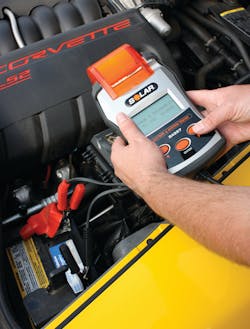CUSTOMER CONCERN:
Intermittent no start where the engine cranks, but does have the juice to fire up.
VEHICLE APPLICATIONS:
All vehicles.
Tests/Procedures for testing batteries (i.e., the "Rich Test"):
- Put multimeter on DC/V and min/max.
- Start the vehicle and record minimum voltage.
- If minimum voltage continues to decline and settles below 9V, the battery is to blame.
TOOLS USED:
- Multimeter
- Labscope
- Load tester
- Battery/starter/alternator diagnostic tool
- Power Probe Hook
Ever get one of those intermittent no starts and the battery has about 12.5V, the alternator is charging and the customer complains that the starter is struggling?
It could be an intermittently weak battery, but it can also be a starter that is starting to bind internally. Thankfully, there is literally a fail-safe method to determine which is bad, even when the car is not acting up and all you need are a few simple tools that you already own.
It should be noted that the following is a technique that was taught by Rich "Shorts" Peterson and it is explained in detail in a class he taught for Technicians Service Training, which is available on DVD.
The "Rich Test"
Testing the battery is the simplest test, requiring only a multimeter with a min/max function. Being that it was invented by Rich Peterson, it is coined the "Rich Test." As stated before, the vehicle does not need to be acting up in order to perform the test and if the battery itself does not require a normal state of charge either.
It is a simple and accurate test. Plus, it does not hurt that the test can be used to sell more batteries and prevent comebacks, simply because it is so accurate that a battery can be sold with 100 percent confidence that it was necessary.
Here's how you do it:
1) Start out by putting a multimeter's probes on the positive and negative battery posts to DC V.
2) Set the meter to min/max, start up the engine and check the minimum voltage by clicking the min/max button. The voltage should not be below 9.5V.
3) Reset the multimeter by turning it off and repeat step two another couple of times. If the battery voltage dips below 9V and then becomes less and less each test, it is a matter of absolute certainty that the battery is bad.
Keep in mind that good batteries will simply have the same minimum voltage after being tested a few times, even to the point where sometimes the battery voltage slightly rises a bit. Bad batteries will lose their surface charge after each consecutive start. By looking at the preceding, even an intermittently bad battery, due to temperature or anything else, can be diagnosed.
This method can also can be used to upsell as battery replacement. Batteries that are getting weak should be replaced as a matter of maintenance.
Battery-specific testers
Another method of testing batteries is with a computerized battery tester or with a battery load tester. These tools are self-explanatory and vary in effectiveness, but they are important in diagnosing battery problems for many vehicles.
For example, hybrid vehicles usually do not allow you to "crank the engine." They either start in all electric mode or the way in which they start does not lend itself to observing dips in battery voltage that the "Rich Test" looks for.
Testing the starter
If the battery checks out, simply put an amp clamp around the negative battery cable and with a multimeter or labscope, do the same test. Using this method, we can test the starter for intermittent defects. Just like the battery test, we start the vehicle three times. Also, just like testing a battery, the amperage should eventually settle and stay the same, instead of changing.
Intermittently bad starters which do not have solenoid issues will tend to have amperages that continue to climb the more they are started, to the point the battery cannot provide the current necessary to turn them over. So if the battery passes, but the starter fails, the starter is to blame.
It should be said that different shops might find different results and might have different methods, but for more details on best practices as it pertains to the "Rich Test" check out his DVD, "Intermittent Electrical Diagnostics."

